Page 280 of 376
280 Practical hintsWhat to do if …Left display
Right display
Possible cause
Possible solution
:
Engine oil level
Check level!
The engine oil level is too low.
�
Check the engine oil level (
�page 228) and
add oil as required.
Engine oil level
Reduce oil level!
You have added too much engine oil.
There is a risk of damaging the en-
gine or the catalytic converter.
�
Have oil siphoned. Observe all legal require-
ments with respect to its disposal.
Engine oil
Visit workshop!
The engine oil has dropped to a crit-
ical level.
There is water in the oil.
�
Check the engine oil level (
�page 228) and
add oil as required.
�
If you must add engine oil frequently, have
the engine checked for possible leaks.
�
Have the oil checked.
Engine oil level
Visit workshop!
The measuring system is malfunc-
tioning.
�
Have the measuring system checked by an
authorized Mercedes-Benz Center.
Page 303 of 376
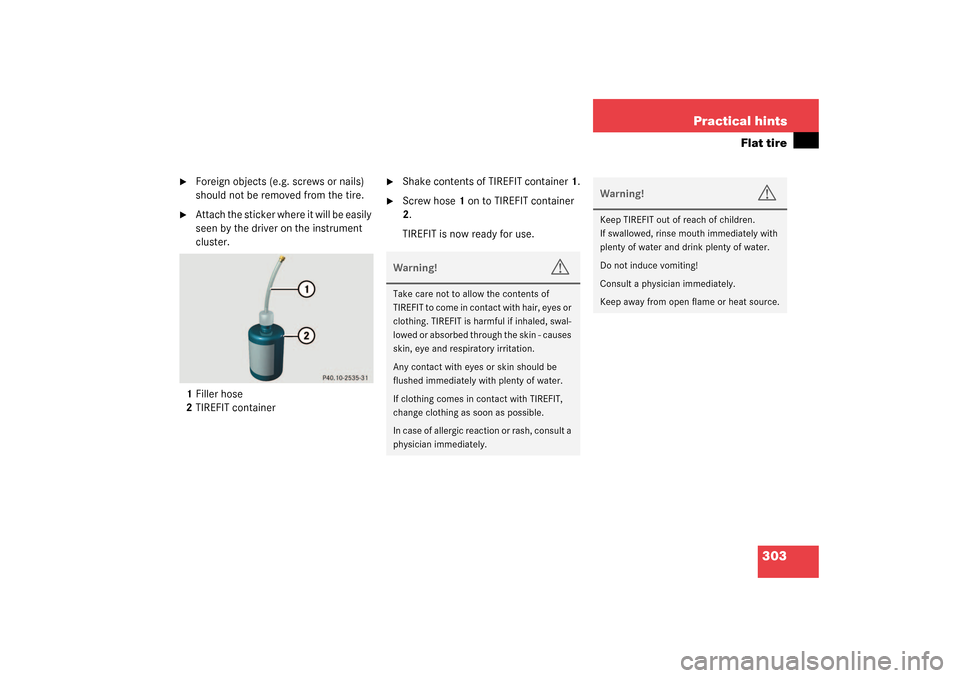
303 Practical hints
Flat tire
�
Foreign objects (e.g. screws or nails)
should not be removed from the tire.
�
Attach the sticker where it will be easily
seen by the driver on the instrument
cluster.
1Filler hose
2TIREFIT container
�
Shake contents of TIREFIT container1.
�
Screw hose1 on to TIREFIT container
2.
TIREFIT is now ready for use.Warning!
G
Take care not to allow the contents of
T I R E F I T t o c o m e i n c o n t a c t w i t h h a i r , e y e s o r
clothing. TIREFIT is harmful if inhaled, swal-
lowed or absorbed through the skin - causes
skin, eye and respiratory irritation.
Any contact with eyes or skin should be
flushed immediately with plenty of water.
If clothing comes in contact with TIREFIT,
change clothing as soon as possible.
In case of allergic reaction or rash, consult a
physician immediately.
Warning!
G
Keep TIREFIT out of reach of children.
If swallowed, rinse mouth immediately with
plenty of water and drink plenty of water.
Do not induce vomiting!
Consult a physician immediately.
Keep away from open flame or heat source.
Page 308 of 376
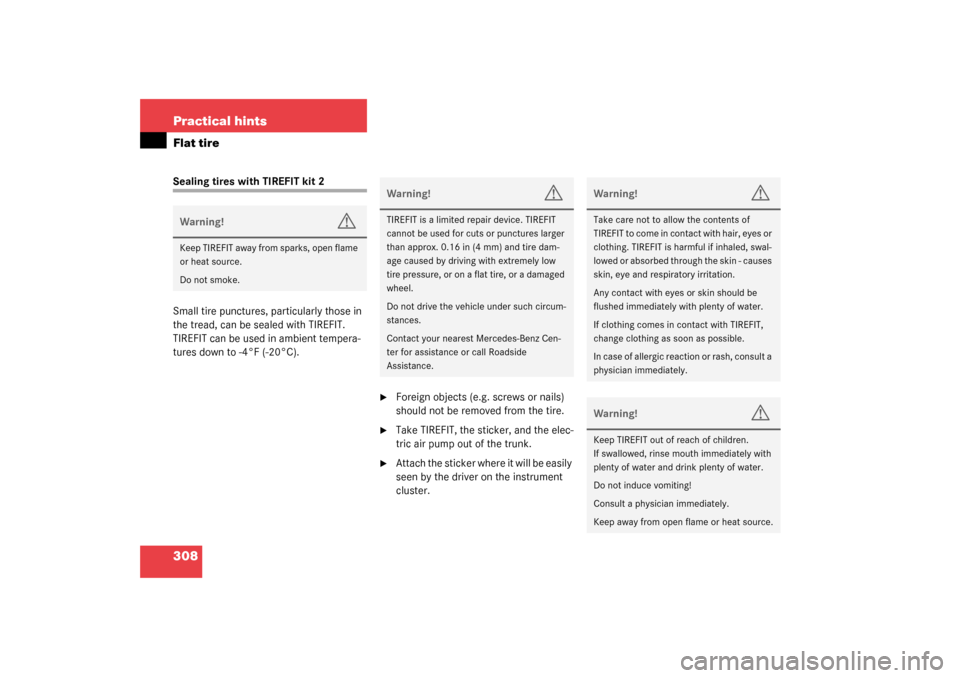
308 Practical hintsFlat tireSealing tires with TIREFIT kit 2
Small tire punctures, particularly those in
the tread, can be sealed with TIREFIT.
TIREFIT can be used in ambient tempera-
tures down to -4°F (-20°C).
�
Foreign objects (e.g. screws or nails)
should not be removed from the tire.
�
Take TIREFIT, the sticker, and the elec-
tric air pump out of the trunk.
�
Attach the sticker where it will be easily
seen by the driver on the instrument
cluster.
Warning!
G
Keep TIREFIT away from sparks, open flame
or heat source.
Do not smoke.
Warning!
G
TIREFIT is a limited repair device. TIREFIT
cannot be used for cuts or punctures larger
than approx. 0.16 in (4 mm) and tire dam-
age caused by driving with extremely low
tire pressure, or on a flat tire, or a damaged
wheel.
Do not drive the vehicle under such circum-
stances.
Contact your nearest Mercedes-Benz Cen-
ter for assistance or call Roadside
Assistance.
Warning!
G
Take care not to allow the contents of
TIREFIT to come in contact with hair, eyes or
clothing. TIREFIT is harmful if inhaled, swal-
lowed or absorbed through the skin - causes
skin, eye and respiratory irritation.
Any contact with eyes or skin should be
flushed immediately with plenty of water.
If clothing comes in contact with TIREFIT,
change clothing as soon as possible.
In case of allergic reaction or rash, consult a
physician immediately.Warning!
G
Keep TIREFIT out of reach of children.
If swallowed, rinse mouth immediately with
plenty of water and drink plenty of water.
Do not induce vomiting!
Consult a physician immediately.
Keep away from open flame or heat source.
Page 322 of 376
322 Practical hintsBatteriesReconnecting the battery for electrical
consumers�
Turn off all electrical consumers.
�
Connect the positive lead and fasten its
cover.
�
Connect the negative lead.
�
Reinstall the trunk floor.
�
Rehook trunk luggage cover into hold-
ers.
!Never invert the terminal connections!iThe following procedures must be car-
ried out following any interruption of
battery power (e.g. due to reconnec-
tion):�
Resynchronize the ESP
(�page 261).
�
Resynchronize side windows
(�page 158).
Page 325 of 376
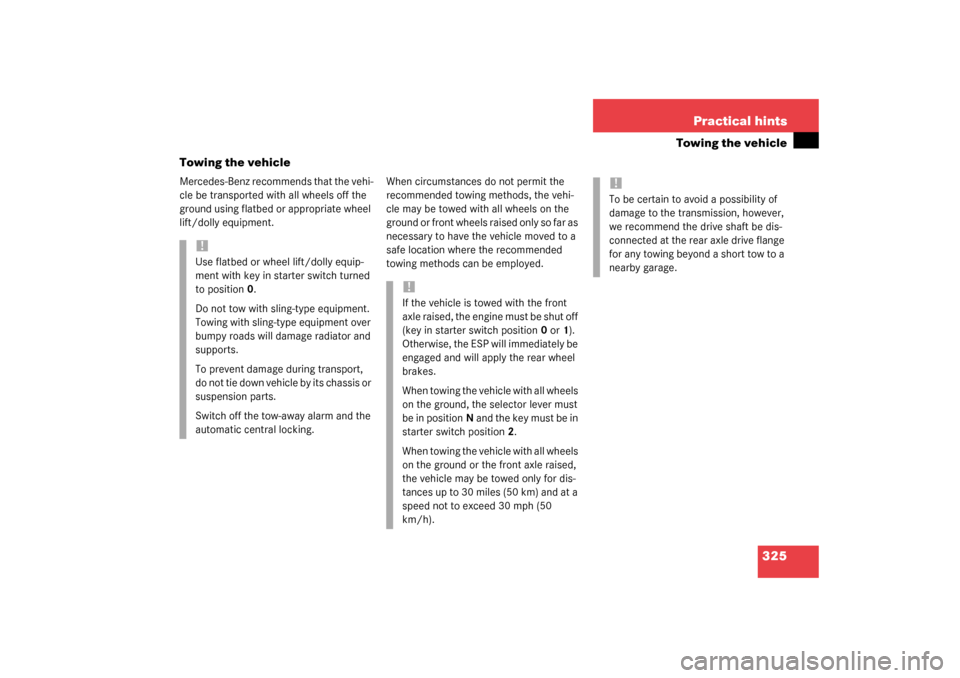
325 Practical hints
Towing the vehicle
Towing the vehicle
Mercedes-Benz recommends that the vehi-
cle be transported with all wheels off the
ground using flatbed or appropriate wheel
lift/dolly equipment.When circumstances do not permit the
recommended towing methods, the vehi-
cle may be towed with all wheels on the
ground or front wheels raised only so far as
necessary to have the vehicle moved to a
safe location where the recommended
towing methods can be employed.
!Use flatbed or wheel lift/dolly equip-
ment with key in starter switch turned
to position0.
Do not tow with sling-type equipment.
Towing with sling-type equipment over
bumpy roads will damage radiator and
supports.
To prevent damage during transport,
do not tie down vehicle by its chassis or
suspension parts.
Switch off the tow-away alarm and the
automatic central locking.
!If the vehicle is towed with the front
axle raised, the engine must be shut off
(key in starter switch position0 or1).
Otherwise, the ESP will immediately be
engaged and will apply the rear wheel
brakes.
When towing the vehicle with all wheels
on the ground, the selector lever must
be in positionN and the key must be in
starter switch position2.
When towing the vehicle with all wheels
on the ground or the front axle raised,
the vehicle may be towed only for dis-
tances up to 30 miles (50 km) and at a
speed not to exceed 30 mph (50
km/h).
!To be certain to avoid a possibility of
damage to the transmission, however,
we recommend the drive shaft be dis-
connected at the rear axle drive flange
for any towing beyond a short tow to a
nearby garage.
Page 336 of 376
336 Technical dataEngine
EngineModel
SL 500 (230.475
(1))
SL 55 AMG (230.474
(1))
Engine
113
113
Mode of operation
4-stroke engine, gasoline injection
4-stroke engine, gasoline injection
No. of cylinders
8
8
Bore
3.82 in (97.00 mm)
3.82 in (97.00 mm)
Stroke
3.31 in (84.00 mm)
3.60 in (92.00 mm)
Total piston displacement
302.9 cu.in. (4966 cm
3)
331.8 cu.in. (5439 cm
3)
Compression ratio
10:1
9:1
Output acc. to SAE J 1349
302 hp / 5 600 rpm
(225 kW / 5 600 rpm)
493 hp / 6 100 rpm
(368 kW / 6 100 rpm)
Maximum torque acc. to SAE J 1349
339 ft.lb / 2 700 rpm
(460 Nm / 2700 rpm)
516 ft.lb / 2 750-4000 rpm
(700 Nm / 2 750-4000 rpm)
Maximum engine speed
6000 rpm
6500 rpm
Firing order
1-5-4-2-6-3-7-8
1-5-4-2-6-3-7-8
Poly-V-belt
7ft 10in (2390mm)
8ft 1in/4ft 3in (2462mm/1289mm)
1The quoted data apply only to the standard vehicle. See an authorized Mercedes-Benz Center for the corresponding data of all special bodies and special equipment.
Page 342 of 376
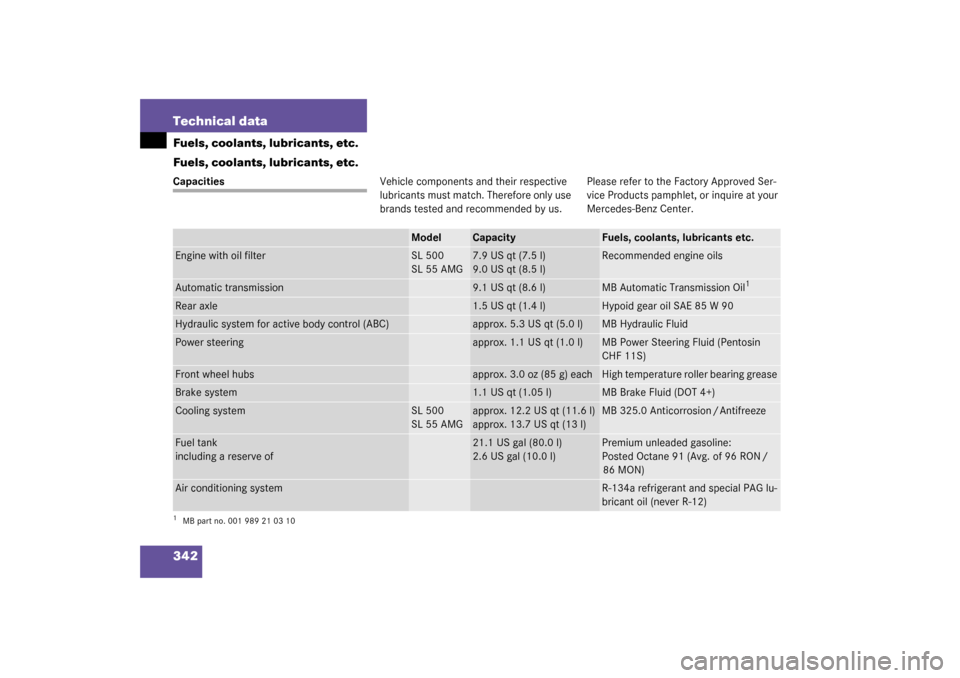
342 Technical dataFuels, coolants, lubricants, etc.
Fuels, coolants, lubricants, etc.CapacitiesVehicle components and their respective
lubricants must match. Therefore only use
brands tested and recommended by us. Please refer to the Factory Approved Ser-
vice Products pamphlet, or inquire at your
Mercedes-Benz Center.
Model
Capacity
Fuels, coolants, lubricants etc.
Engine with oil filter
SL 500
SL 55 AMG
7.9 US qt (7.5 l)
9.0 US qt (8.5 l)
Recommended engine oils
Automatic transmission
9.1 US qt (8.6 l)
MB Automatic Transmission Oil
1
Rear axle
1.5 US qt (1.4 l)
Hypoid gear oil SAE 85 W 90
Hydraulic system for active body control (ABC)
approx. 5.3 US qt (5.0 l)
MB Hydraulic Fluid
Power steering
approx. 1.1 US qt (1.0 l)
MB Power Steering Fluid (Pentosin
CHF 11S)
Front wheel hubs
approx. 3.0 oz (85 g) each
High temperature roller bearing grease
Brake system
1.1 US qt (1.05 l)
MB Brake Fluid (DOT 4+)
Cooling system
SL 500
SL 55 AMG
approx. 12.2 US qt (11.6 l)
approx. 13.7 US qt (13 l)
MB 325.0 Anticorrosion / Antifreeze
Fuel tank
including a reserve of
21.1 US gal (80.0 l)
2.6 US gal (10.0 l)
Premium unleaded gasoline:
Posted Octane 91 (Avg. of 96 RON /
86 MON)
Air conditioning system
R-134a refrigerant and special PAG lu-
bricant oil (never R-12)
1MB part no. 001 989 21 03 10
Page 344 of 376
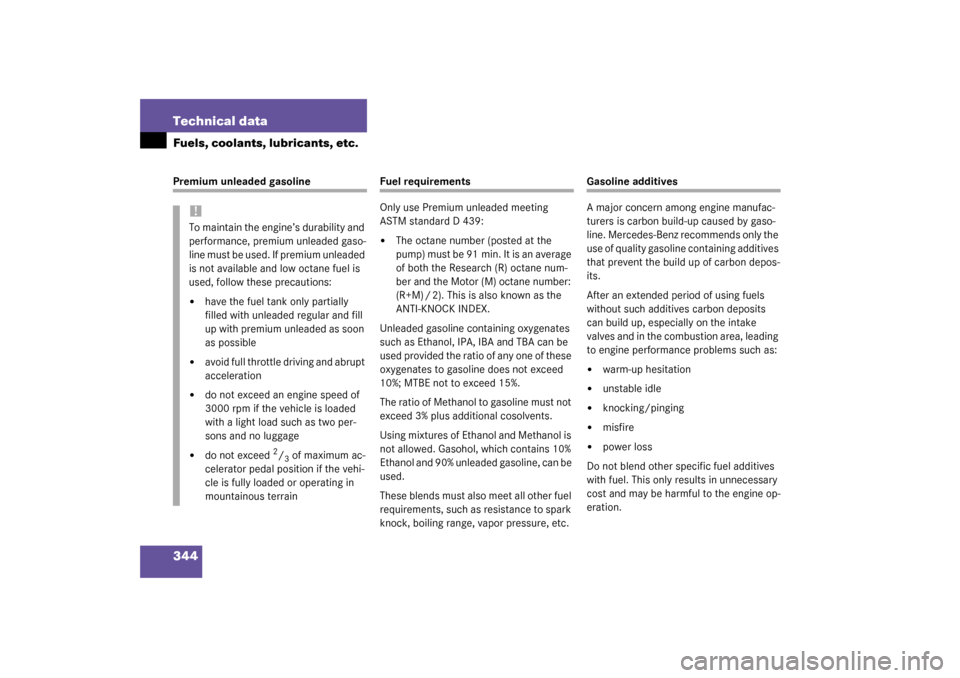
344 Technical dataFuels, coolants, lubricants, etc.Premium unleaded gasoline
Fuel requirements
Only use Premium unleaded meeting
ASTM standard D 439:�
The octane number (posted at the
pu mp ) m us t b e 91 mi n. It is an a ve ra ge
of both the Research (R) octane num-
ber and the Motor (M) octane number:
(R+M) / 2). This is also known as the
ANTI-KNOCK INDEX.
Unleaded gasoline containing oxygenates
such as Ethanol, IPA, IBA and TBA can be
used provided the ratio of any one of these
oxygenates to gasoline does not exceed
10%; MTBE not to exceed 15%.
The ratio of Methanol to gasoline must not
exceed 3% plus additional cosolvents.
Using mixtures of Ethanol and Methanol is
not allowed. Gasohol, which contains 10%
Ethanol and 90% unleaded gasoline, can be
used.
These blends must also meet all other fuel
requirements, such as resistance to spark
knock, boiling range, vapor pressure, etc.
Gasoline additives
A major concern among engine manufac-
turers is carbon build-up caused by gaso-
line. Mercedes-Benz recommends only the
use of quality gasoline containing additives
that prevent the build up of carbon depos-
its.
After an extended period of using fuels
without such additives carbon deposits
can build up, especially on the intake
valves and in the combustion area, leading
to engine performance problems such as:�
warm-up hesitation
�
unstable idle
�
knocking/pinging
�
misfire
�
power loss
Do not blend other specific fuel additives
with fuel. This only results in unnecessary
cost and may be harmful to the engine op-
eration.
!To maintain the engine’s durability and
performance, premium unleaded gaso-
line must be used. If premium unleaded
is not available and low octane fuel is
used, follow these precautions:�
have the fuel tank only partially
filled with unleaded regular and fill
up with premium unleaded as soon
as possible
�
avoid full throttle driving and abrupt
acceleration
�
do not exceed an engine speed of
3000 rpm if the vehicle is loaded
with a light load such as two per-
sons and no luggage
�
do not exceed
2/3 of maximum ac-
celerator pedal position if the vehi-
cle is fully loaded or operating in
mountainous terrain